Kreg KMA3225 Shelf Pin Jig Le manuel du propriétaire
- Taper
- Le manuel du propriétaire

English 2
French (N. America) 13
Spanish (N. America) 25
French 37
Spanish 49
German 61
OWNER’S MANUAL
We’re here to help.
We want you to have an exceptional project building experience.
If you have questions or need support, please get in touch.
1-800-447-8638 | [email protected]
Tell us about your experience.
Your opinion counts. And we’re always looking for ways to
improve. Share your feedback so we can keep growing and
innovating for you. www.kregtool.com/feedback
WARNING Every user must read and follow instructions and safety
precautions in this manual. Failure to do so could result in serious injury.
Save manual for future reference.
Kreg Shelf Pin Jig
Manual applies to Item # KMA3225, KMA3232, and KMA3232-INT

2
Safety Precautions
WARNING Before using a power tool with this product, read, and follow the
tool manufacturer’s instructions and safety precautions in addition to the safety
precautions below to reduce risk of serious injury from hazards such as re, electric
shock, or rotating drill bit.
■Follow your drill manufacturer’s safety guidelines.
■Follow your clamp manufacturer’s safety guidelines. Keep your hands clear when
clamping to avoid pinch points. The clamping limit on this jig is 300 lbs.
■When drilling, always ensure that the workpiece is clamped securely. It is
dangerous to hold the workpiece in place by hand.
■The drill bit is sharp; handle with care and avoid unintended cutting. The drill bit
may be hot after repetitive use.
■Always wear personal protective equipment certied as adequate in addition to
what your drill manufacturer requires.
■Do not allow familiarity gained from frequent use of your tools to replace safe work
practices. A moment of carelessness is sufcient to cause severe injury.
WARNING Avoid awkward hand positions where a sudden slip could cause contact
with the rotating drill bit.
WARNING Do not operate this tool or any machinery while under the inuence of
drugs, alcohol, or medications.
WARNING This product can expose you to chemicals including Acrylonitrile and
other chemicals, which are known to the State of California to cause cancer and
reproductive harm. For more information go to www.P65Warnings.ca.gov.
WARNING Drilling, sawing, sanding, or machining wood products can expose you
to wood dust, a substance known to the State of California to cause cancer. Avoid
inhaling wood dust or use a dust mask or other safeguards for personal protection.
For more information go to www.P65Warnings.ca.gov/wood.
Table of Contents
Safety Precautions . . . . . . . . . . 2
Pre-Assembly. . . . . . . . . . . . . 3
Assembly . . . . . . . . . . . . . . . 4
Face-Framed Cabinets . . . . . . . . 5
Frameless Cabinets . . . . . . . . . 6
Operation . . . . . . . . . . . . . . . 8
Using the Jig for Cabinet Hardware
Installation . . . . . . . . . . . . . . 9
Connect Jigs Together . . . . . . . .11
Maintenance . . . . . . . . . . . . .11
Care and Cleaning . . . . . . . . . .11
Troubleshooting . . . . . . . . . . .11
Accessories. . . . . . . . . . . . . .11

3
Pre-Assembly
Review this section before you begin. Ensure you have all tools/materials on hand and
compare the package with the items listed in the Product Description section. If any
item appears missing or lost, do not use this product. Contact Technical Support or
return product to place of purchase.
Recommended Tools/Materials
Clamp Pencil
Product Description
F
B
A
C
DE
G
H
Part Description Part Description
A Shelf Pin Jig E** Indexing pin
B Fence F Jig extension
C* Drill bit G Hex wrench
D Stop collar with set screw H 1/4" or 5 mm Shelf pins (4x)
*If replacement or different size drill bits are needed, 1/4" or 5 mm drill bits are available
separately.
**The indexing pin is double ended for both 1/4" and 5 mm shelf pin holes.

4
Onboard Tool Storage
The jig (A) provides onboard storage
for these items:
■Hex wrench (G)
■Indexing pin (E)
■Drill bit (C) with
stop collar (D) attached
Assembly
1 Set the Stop Collar on the Drill Bit
a. Slide the stop collar (D) onto the drill bit (C).
b. Place the drill bit (C) and stop collar (D) into the storage slot on the back of the
jig (A).
c. Slide the end of the drill bit (C) into the hole on the edge of the storage slot until
it stops.
d. Position the stop collar (D) into the recess of the storage slot.
e. Use the hex wrench (G) to tighten the set screw in the stop collar (D).
C
D
A
G
G DCE

5
2 Identify Your Cabinet Type
For face-framed cabinets, continue to the
next section.
For frameless cabinets, skip to Attach
the Fence to the Jig (page 6).
Face-Framed Cabinets
1 Position the Jig
Tip Although you can use either the top
or bottom of the jig for reference, we
recommend using the top so that you
can use the jig extension as you move
downward. Use the same reference end
of the jig while drilling all shelf pin holes
to maintain accurate left to right and
front to back alignment.
a. Align the jig with the inside corner of
the cabinet and the face-frame.

6
2 Clamp the Jig
WARNING Follow your clamp
manufacturer’s safety guidelines. Keep
your hands clear when clamping to avoid
pinch points. The clamping limit on this
jig is 300 lbs.
a. Use a clamp in the location shown
below to secure the jig (A) in place.
b. If using two connected jigs, clamp
both.
Tip If your cabinet is already assembled,
remove the fence and place the jig
against the back of the cabinet using the
same reference point as the front and
carefully hold in place while you drill your
rst hole. Then use the jig extender and
index pin to continue.
Frameless Cabinets
1 Attach the Fence to the Jig
a. Insert the fence (B) into the jig (A) base.
b. Slide the fence (B) horizontally to secure it in place.
A
B
BA
Note To remove the fence (B), slide the fence horizontally and pull away from the
jig(A).

7
2 Position the Jig
Tip Although you can use either the top
or bottom of the jig for reference, we
recommend using the top so that you
can use the jig extension as you move
downward. Use the same reference end
of the jig while drilling all shelf pin holes
to maintain accurate left to right and
front to back alignment.
Note When moving from the front to
back holes, attach the fence to the other
side of the jig.
a. Align the jig with the inside corner of
the cabinet and the fence with the
front of the cabinet.
3 Clamp the Jig
WARNING Follow your clamp
manufacturer’s safety guidelines. Keep
your hands clear when clamping to avoid
pinch points. The clamping limit on this
jig is 300 lbs.
a. Use a clamp in the location shown
below to secure the jig (A) in place.
b. If using two connected jigs, clamp
both.
Tip If your cabinet is already assembled,
remove the fence and place the jig
against the back of the cabinet using the
same reference point as the front and
carefully hold in place while you drill your
rst hole. Then use the jig extender and
index pin to continue.

8
Operation
1 Drilling the Shelf Pin
Holes
WARNING When drilling, always ensure
that the workpiece is clamped securely.
It is dangerous to hold the workpiece
in place by hand. The drill bit is sharp;
handle with care and avoid unintended
cutting. The drill bit may be hot after
repetitive use.
a. Place your prepared drill bit (C) with
stop collar (D) into your drill.
b. Insert your drill bit (C) into the drill
guide (1) and bring your drill up to
speed before contacting the wood.
c. Drill until the stop collar (D) stops
going any deeper due to contact
with the drill guide.
d. Remove the drill bit (C) from the
drill guide while the drill bit is still
rotating.
1
C
D
2 Drilling an Extended Run
of Shelf Pin Holes
Note The drill extension does not have
a drill guide and should not be used for
drilling.
a. Drill the rst set of shelf pin holes.
b. Unclamp the jig (A).
c. Connect the jig extension (F) to the
top of the jig (A).
d. Slide the jig (A) to align the jig
extension (F) hole with the last shelf
pin hole.
e. Insert the indexing pin (E) through
the jig extension (F) and shelf pin
hole to stabilize the jig (A).
f. Clamp the jig (A) in place.
g. Drill the next set of shelf pin holes.
Tip If you need to start your holes from
the bottom, remove the jig extension (F)
and use the indexing pin (E) in the drill
guides and existing holes for alignment.
A
E
F

9
Using the Jig for Cabinet Hardware Installation
When building frameless cabinets, the jig can be used to correctly mount concealed
hinge plates and rst hole alignment for most drawer slides.
Note Check your hardware mounting instructions before drilling. The drill guide holes
are 1.45" (37 mm) from the sides of the jig with 1.25" (32 mm) between holes.
Marking Concealed Hinge Mounting Holes
a. Mark the desired center line of the hinge on the cabinet.
b. Position the jig (A) using the position indicator window to align the center of the
two drill guide holes.
c. Clamp the jig to the frameless cabinet.
Important To use the provided screws from the hinge manufacturer, only use the drill
bit to mark the location of the screws.
d. If using a standard
wood screw, bring your
drill up to speed and
lightly touch the cabinet
to break the surface.
e. If using a 5 mm
system screw, use
the 5 mm drill bit to
drill the hole.
A

10
Marking Drawer Slide Mounting Holes
a. Mark the desired center line of the drawer slide on the cabinet.
b. Position the jig (A) using the position indicator window to align the drill guide
hole.
c. Clamp the jig to the frameless cabinet.
Important To use the provided screws from the slide manufacturer, only use the drill
bit to mark the location of the screws.
d. If using a standard
wood screw, bring your
drill up to speed and
lightly touch the cabinet
to break the surface.
e. If using a 5 mm
system screw, use
the 5 mm drill bit to
drill the hole.
f. Attach the slide with the rst screw and level to attach the remaining screws.
A

11
Connect Jigs Together
Connect two or more jigs together for
longer drilling capability. Insert the top
of the second jig into the extension
connector at the bottom of the rst jig.
Maintenance
Keep all parts clean of dust and debris.
Replace the drill bit when it is dull.
Care and Cleaning
To clean, wipe with a clean rag or blow compressed air on all parts.
To store, place all parts and hardware into the storage positions on the back of the jig.
Troubleshooting
Problem Possible Cause Solution
It is difcult to drill
the hole. The drill is in reverse. Check and reset the drill to forward.
It is difcult to drill
the hole. The bit is dull. Replace the bit.
There is excessive
tear out on holes.
The bit is dull. Replace the bit.
The jig is not clamped
properly. Check and clamp the jig properly.
The drill bit is started while it
is in contact with the wood.
Insert the drill bit into the drill guide
and bring the drill up to speed before
contacting the wood.
The side to side
alignment is off.
Not using the same
reference end.
Use the same reference end for both
sides of the cabinet.
Accessories
KMA3210 1/4" Shelf Pin Jig Drill Bit KMA3215 5 mm Shelf Pin Jig Drill Bit

1/2021 105707 V1
EXPLORE. BUILD. SHARE.
We’re makers just like you.
That’s why we love to see what you’re working on.
Share with the community and get inspired!
#madewithKreg
Get free plans, project resources, and more.
kregtool.com and buildsomething.com

GUIDE D’UTILISATEUR
Nous sommes là pour vous aider.
Nous voulons que votre projet de construction se déroule de manière optimale.
Si vous avez des questions ou si vous avez besoin d’aide, n’hésitez pas à nous contacter.
1800447-8638 | [email protected]
Parlez-nous de votre expérience.
Votre opinion compte. Et nous sommes toujours à la recherche de moyens de nous améliorer.
Partagez vos commentaires an que nous puissions continuer à croître et à innover, pour vous.
www.kregtool.com/feedback
AVERTISSEMENT Chaque utilisateur doit lire et suivre les instructions et les
précautions de sécurité de ce manuel. Respectez cette consigne an d’éviter
tout risque de blessures graves. Conservez le manuel pour une utilisation
ultérieure.
Gabarit pour les goupilles d’étagère Kreg
Le guide s’applique aux articles n° KMA3225, KMA3232 et KMA3232-INT

14
Précautions de sécurité
AVERTISSEMENT Avant d’utiliser un outil électrique avec ce produit, veuillez lire et
suivre les instructions et les précautions de sécurité du fabricant de l’outil, en plus
des précautions de sécurité ci-dessous, an de réduire le risque de blessures graves
dues à des risques comme le feu, les chocs électriques ou les mèches de forage
rotatives.
■Suivez les consignes de sécurité du fabricant de votre perceuse.
■Suivez les consignes de sécurité du fabricant de votre serre-joint. Gardez vos
mains éloignées lors du serrage pour éviter les points de pincement. La limite de
serrage de ce gabarit est de 300lb (136kg).
■Lors du perçage, assurez-vous toujours que la pièce de travail est solidement
ancrée en place. Il est dangereux de tenir une pièce de travail en place à l’aide de
votre main.
■La mèche de forage est aiguisée; manipulez-la avec précaution et évitez de faire
des coupes involontairement. La mèche de forage peut être chaude à la suite
d’une utilisation continue.
■Portez toujours l’équipement de protection personnelle adéquat en plus de ce que
conseille le fabricant de votre perceuse.
■Faites attention lorsque vous devenez familier avec l’outil en raison d’une utilisation
fréquente. Employez systématiquement des pratiques de travail sécuritaires. Un
moment d’inattention est sufsant pour causer des blessures graves.
AVERTISSEMENT Évitez de positionner vos mains de la mauvaise façon, car un
glissement soudain pourrait causer un contact avec la mèche de forage en rotation.
AVERTISSEMENT N’utilisez pas cet outil ou toute autre machine lorsque vous êtes
sous l’inuence de drogues, d’alcool ou de médicaments.
AVERTISSEMENT Ce produit peut vous exposer à des produits chimiques,
notamment l’acrylonitrile ou d’autres types dont l’État de Californie reconnait être
cancérigènes et nocifs pour la reproduction. Pour en savoir plus, visitez www.
P65Warnings.ca.gov.
AVERTISSEMENT Le perçage, le sciage, le ponçage ou l’usinage des produits du
bois peuvent vous exposer à la poussière de bois, une substance reconnue par
l’État de Californie comme étant cancérigène. Évitez d’inhaler la poussière de bois
ou utilisez un masque anti-poussière ou d’autres mesures de protection personnelle.
Pour en savoir plus, visitez www.P65Warnings.ca.gov/wood.
Table des matières
Précautions de sécurité . . . . . . .14
Avant l’assemblage. . . . . . . . . .15
Assemblage. . . . . . . . . . . . . .16
Armoires à cadre . . . . . . . . . . .17
Armoires sans cadre . . . . . . . . .18
Mode d’emploi . . . . . . . . . . . .20
Utilisation du gabarit pour l’installation
de la quincaillerie dans l’armoire . .21
Connecter les gabarits ensemble . .23
Maintenance . . . . . . . . . . . . .23
Entretien et nettoyage . . . . . . . .23
Dépannage . . . . . . . . . . . . . .23
Accessoires. . . . . . . . . . . . . .23

15
Avant l’assemblage
Consultez cette section avant de commencer. Assurez-vous d’avoir tous les outils
et les matériaux à portée de main et comparez ce qui se trouve dans l’emballage du
produit avec les articles énumérés dans la section Description du produit. Si un article
semble manquant ou perdu, n’utilisez pas ce produit. Contactez le support technique
ou retournez le produit où vous l’avez acheté.
Outils/Matériel recommandés
Serre-joint Crayon
Description du produit
F
B
A
C
DE
G
H
Pièce Description Pièce Description
AGabarit pour les goupilles
d’étagère E** Goupille de positionnement
B Clôture F Extension du gabarit
C* Mèche de forage G Clé hexagonale
DBague d’arrêt avec vis de
blocage HGoupilles d’étagère de
1/4po ou 5mm (4x)
*Si des mèches de forage de remplacement ou de taille différente sont nécessaires, des
mèches de 1/4po ou de 5mm sont disponibles séparément.
**La goupille de positionnement est à double extrémité pour les trous pour les goupilles
d’étagère de 1/4po et 5mm.

16
Rangement pour outils intégré
Le gabarit (A) offre un espace de
rangement intégré pour les objets suivants:
■Clé hexagonale (G)
■Goupille de positionnement (E)
■Mèche de forage (C) avec bague
d’arrêt (D) intégrée
Assemblage
1 Réglage de la bague d’arrêt sur la mèche de forage
a. Faites glisser la bague d’arrêt (D) sur la mèche de forage (C).
b. Placez la mèche de forage (C) et la bague d’arrêt (D) dans la fente de rangement
à l’arrière du gabarit (A).
c. Faites glisser l’extrémité de la mèche de forage (C) dans le trou situé sur le bord
de la fente de rangement jusqu’à ce qu’elle s’arrête.
d. Positionnez la bague d’arrêt (D) dans l’orice de la fente de rangement.
e. Utilisez la clé hexagonale (G) pour serrer la vis de réglage dans la bague d’arrêt
(D).
C
D
A
G
G DCE

17
2 Déterminer votre type d’armoire
Pour les armoires à cadre, passez à la
section suivante.
Pour les armoires sans cadre, passez
à la section Fixer la clôture au gabarit
(page 18).
Armoires à cadre
1 Positionner le gabarit
Astuce Bien que vous puissiez utiliser
le haut ou le bas du gabarit comme
référence, nous vous recommandons
d’utiliser le haut an de pouvoir utiliser
l’extension du gabarit lorsque vous
vous déplacez vers le bas. Utilisez la
même extrémité de référence du gabarit
tout en perçant tous les trous pour les
goupilles de l’étagère pour maintenir un
alignement précis de gauche à droite et
d’avant en arrière.
a. Alignez le gabarit avec le coin
intérieur de l’armoire et le cadre.

18
2 Serrez le gabarit
AVERTISSEMENT Suivez les consignes
de sécurité du fabricant de votre serre-
joint. Gardez vos mains éloignées lors
du serrage pour éviter les points de
pincement. La limite de serrage de ce
gabarit est de 300lb (136kg).
a. Utilisez un serre-joint à l’endroit
indiqué ci-dessous pour xer le
gabarit (A) en place.
b. Si vous utilisez deux gabarits
connectés, serrez les deux.
Astuce Si votre armoire est déjà
assemblée, retirez la clôture et placez
le gabarit contre l’arrière de l’armoire
en utilisant le même point de référence
que pour l’avant et maintenez-le
soigneusement en place pendant
que vous percez votre premier trou.
Utilisez ensuite l’extension de gabarit
et la goupille de positionnement pour
continuer.
Armoires sans cadre
1 Attacher la clôture au gabarit
a. Insérez la clôture (B) dans la base du gabarit (A).
b. Faites glisser la clôture (B) horizontalement pour la maintenir en place.
A
B
BA
Remarque Pour enlever la clôture (B), faites-la glisser horizontalement et éloignez-la
du gabarit (A).

19
2 Positionner le gabarit
Astuce Bien que vous puissiez utiliser
le haut ou le bas du gabarit comme
référence, nous vous recommandons
d’utiliser le haut an de pouvoir utiliser
l’extension du gabarit lorsque vous
vous déplacez vers le bas. Utilisez la
même extrémité de référence du gabarit
tout en perçant tous les trous pour les
goupilles de l’étagère pour maintenir un
alignement précis de gauche à droite et
d’avant en arrière.
Remarque Lorsque vous passez des
trous avant aux trous arrière, xez la
clôture de l’autre côté du gabarit.
a. Alignez le gabarit avec le coin
intérieur de l’armoire et le cadre
frontal.
3 Serrez le gabarit
AVERTISSEMENT Suivez les consignes
de sécurité du fabricant de votre serre-
joint. Gardez vos mains éloignées lors
du serrage pour éviter les points de
pincement. La limite de serrage de ce
gabarit est de 300lb (136kg).
a. Utilisez un serre-joint à l’endroit
indiqué ci-dessous pour xer le
gabarit (A) en place.
b. Si vous utilisez deux gabarits
connectés, serrez les deux.
Astuce Si votre armoire est déjà
assemblée, retirez la clôture et placez
le gabarit contre l’arrière de l’armoire
en utilisant le même point de référence
que pour l’avant et maintenez-le
soigneusement en place pendant
que vous percez votre premier trou.
Utilisez ensuite l’extension de gabarit
et la goupille de positionnement pour
continuer.

20
Mode d’emploi
1 Percer les trous pour les
goupilles d’étagère
AVERTISSEMENT Lors du perçage,
assurez-vous toujours que la pièce de
travail est solidement ancrée en place.
Il est dangereux de tenir une pièce de
travail en place à l’aide de votre main.
La mèche de forage est aiguisée;
manipulez-la avec précaution et évitez
de faire des coupes involontairement. La
mèche de forage peut être chaude à la
suite d’une utilisation continue.
a. Placez votre mèche de forage
préparée (C) avec la bague d’arrêt
placée (D) dans la mèche.
b. Insérez votre mèche de forage (C)
dans le guide-foret (1) et mettez
votre perceuse en marche avant de
toucher le bois.
c. Percez jusqu’à ce que la bague
d’arrêt (D) cesse de s’enfoncer en
raison du contact avec le guide-
foret.
d. Retirez la mèche de forage (C) du
guide-foret pendant que la mèche
est encore en rotation.
1
C
D
2 Perçage d’une série
étendue de trous pour les
goupilles d’étagère
Remarque L’extension de la perceuse
n’a pas de guide-foret et ne doit pas être
utilisée pour le perçage.
a. Percez la première série de trous
pour les goupilles de l’étagère.
b. Desserrez le gabarit (A).
c. Reliez l’extension du gabarit (F) au
sommet du gabarit (A).
d. Faites glisser le gabarit (A) pour
aligner le trou de l’extension du
gabarit (F) avec le dernier trou pour
les goupilles de l’étagère.
e. Insérez la goupille de
positionnement (E) à travers
l’extension du gabarit (F) et le trou
pour les goupilles de l’étagère pour
stabiliser le gabarit (A).
f. Serrez le gabarit (A) en place.
g. Percez la prochaine série de trous
pour les goupilles d’étagère.
Astuce Si vous devez commencer
vos trous par le bas, retirez l’extension
du gabarit (F) et utilisez la goupille de
positionnement (E) dans les guides-
forets et les trous existants pour
l’alignement.
A
E
F
La page est en cours de chargement...
La page est en cours de chargement...
La page est en cours de chargement...
La page est en cours de chargement...
La page est en cours de chargement...
La page est en cours de chargement...
La page est en cours de chargement...
La page est en cours de chargement...
La page est en cours de chargement...
La page est en cours de chargement...
La page est en cours de chargement...
La page est en cours de chargement...
La page est en cours de chargement...
La page est en cours de chargement...
La page est en cours de chargement...
La page est en cours de chargement...
La page est en cours de chargement...
La page est en cours de chargement...
La page est en cours de chargement...
La page est en cours de chargement...
La page est en cours de chargement...
La page est en cours de chargement...
La page est en cours de chargement...
La page est en cours de chargement...
La page est en cours de chargement...
La page est en cours de chargement...
La page est en cours de chargement...
La page est en cours de chargement...
La page est en cours de chargement...
La page est en cours de chargement...
La page est en cours de chargement...
La page est en cours de chargement...
La page est en cours de chargement...
La page est en cours de chargement...
La page est en cours de chargement...
La page est en cours de chargement...
La page est en cours de chargement...
La page est en cours de chargement...
La page est en cours de chargement...
La page est en cours de chargement...
La page est en cours de chargement...
La page est en cours de chargement...
La page est en cours de chargement...
La page est en cours de chargement...
La page est en cours de chargement...
La page est en cours de chargement...
La page est en cours de chargement...
La page est en cours de chargement...
La page est en cours de chargement...
La page est en cours de chargement...
La page est en cours de chargement...
La page est en cours de chargement...
-
 1
1
-
 2
2
-
 3
3
-
 4
4
-
 5
5
-
 6
6
-
 7
7
-
 8
8
-
 9
9
-
 10
10
-
 11
11
-
 12
12
-
 13
13
-
 14
14
-
 15
15
-
 16
16
-
 17
17
-
 18
18
-
 19
19
-
 20
20
-
 21
21
-
 22
22
-
 23
23
-
 24
24
-
 25
25
-
 26
26
-
 27
27
-
 28
28
-
 29
29
-
 30
30
-
 31
31
-
 32
32
-
 33
33
-
 34
34
-
 35
35
-
 36
36
-
 37
37
-
 38
38
-
 39
39
-
 40
40
-
 41
41
-
 42
42
-
 43
43
-
 44
44
-
 45
45
-
 46
46
-
 47
47
-
 48
48
-
 49
49
-
 50
50
-
 51
51
-
 52
52
-
 53
53
-
 54
54
-
 55
55
-
 56
56
-
 57
57
-
 58
58
-
 59
59
-
 60
60
-
 61
61
-
 62
62
-
 63
63
-
 64
64
-
 65
65
-
 66
66
-
 67
67
-
 68
68
-
 69
69
-
 70
70
-
 71
71
-
 72
72
Kreg KMA3225 Shelf Pin Jig Le manuel du propriétaire
- Taper
- Le manuel du propriétaire
dans d''autres langues
Documents connexes
-
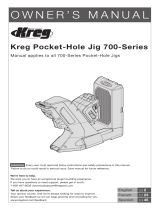 Kreg Pocket-Hole Jig 720PRO Manuel utilisateur
Kreg Pocket-Hole Jig 720PRO Manuel utilisateur
-
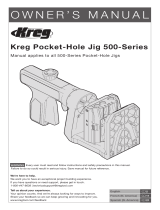 Kreg Pocket-Hole Jig 520PRO Manuel utilisateur
Kreg Pocket-Hole Jig 520PRO Manuel utilisateur
-
Kreg KPHJ230 Le manuel du propriétaire
-
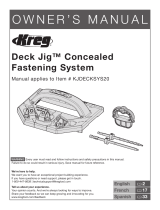 Kreg Deck Jig Manuel utilisateur
Kreg Deck Jig Manuel utilisateur
-
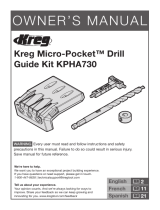 Kreg Micro-Pocket Drill Guide Kit 730 Manuel utilisateur
Kreg Micro-Pocket Drill Guide Kit 730 Manuel utilisateur
-
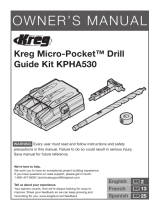 Kreg Micro-Pocket Drill Guide Kit 530 Manuel utilisateur
Kreg Micro-Pocket Drill Guide Kit 530 Manuel utilisateur
-
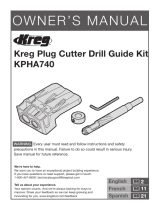 Kreg Custom Plug Cutter Drill Guide Kit Manuel utilisateur
Kreg Custom Plug Cutter Drill Guide Kit Manuel utilisateur
-
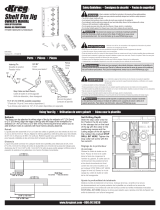 Kreg KMA3200 Manuel utilisateur
Kreg KMA3200 Manuel utilisateur
-
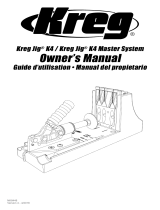 Kreg Jig K4 Manuel utilisateur
Kreg Jig K4 Manuel utilisateur
-
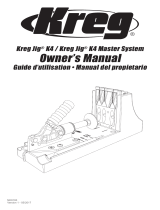 Kreg Jig K4 Manuel utilisateur
Kreg Jig K4 Manuel utilisateur
















































































